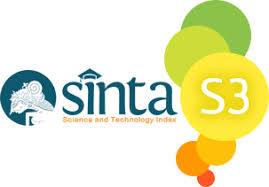Proses simulasi- simulakra-hiperealitas dalam majelis taklim jn Surabaya
 Abstract views: 391
,
Abstract views: 391
,
 PDF downloads: 401
PDF downloads: 401
Abstract
The Taklim Council carries out a series of activities that are believed to be a way to emigrate, change, and transform in order to improve themselves by getting closer to the Creator. By attending one of the recitations at the JN Surabaya Taklim Council, the congregation also participated in the transformation. The purpose of this study was to determine the simulacra-simulation-hypereality process in the JN Surabaya Taklim Council. This study uses a descriptive qualitative approach that describes the process that researchers use to interpret the activities of the JN Surabaya Taklim Council and see the activities (events) from various angles. The results of this study indicate that the process of simulating the JN Surabaya Taklim Council has produced a new meaning for the congregation towards the Taklim Council itself, namely the meaning of Real value and Exit Value.
References
Brewerton, T. (1994). Hyperreligiosity in psychotic disorders. Journal of Nervous and Mental Disease, 182(5), 302–305.
Burhanuddin, J. (2002). Ulama Perempuan Indonesia. Gramedia Pustaka Utama.
Denzin, N. K., & Lincoln, Y. S. (2011). The Sage Handbook of Qualitative Research (fourth Edi). SAGE Publications, Inc; Fourth edition (April 27, 2011).
Dhofier, Z. (2011). Tradisi pesantren: studi pandangan hidup kyai dan visinya mengenai masa depan Indonesia. Lp3es.
Garcia-Santibanez, R., & Sarva, H. (2015). Isolated hyperreligiosity in a patient with temporal lobe epilepsy. Case Reports in Neurological Medicine, 2015.
Huberman, A., Miles, M., & Saldana, J. (2014). Qualitative data analysis: A methods sourcebook. The United States of America: SAGE Publications.
Ibrahim, I., & Akhmad, B. (2014). Komunikasi dan Komodifikasi: Mengkaji Media dan Budaya dalam Dinamika Globalisasi. Jakarta: Obor.
Jalaluddin. (2016). Psikologi Agama, Memahami Perilaku dengan Mengaplikasikan Prinsip-Prinsip Psikologi. Jakarta: Raja Grafindo.
Jatim.bps.go.id. (2017). Jumlah Penduduk Menurut Kabupaten/Kota dan Agama yang Dianut di Provinsi Jawa Timur, 2016. https://jatim.bps.go.id/dynamictable/2017/10/09/120/jumlah-penduduk-menurut-kabupaten-kota-dan-agama-yang-dianut-di-provinsi-jawa-timur-2016
Kitiarsa, P. (2008). Buddah Phanit Thailand’s Prosperity Religion and Its Commodities Tactics Religious Commodifications in Asia Marketing Gods. London: Routledge.
Krathwohl, D., Bloom, B., & Masia, B. (1964). Taxonomy of educational objectives, handbook II: affective domain. New York: Longman.
Meuleman, J. (2011). Dakwah, competition for authority, and development. Bijdragen Tot de Taal-, Land-En Volkenkunde/Journal of the Humanities and Social Sciences of Southeast Asia, 167(2–3), 236–269.
Moleong, L. (2017). Metodologi penelitian kualitatif. Bandung: Remaja Rosdakarya.
Neuman, W. L. (2014). Social Research Methods: Qualitative and Quantitative Approaches. In Teaching Sociology (Vol. 30, Issue 3). https://doi.org/10.2307/3211488
Ogata, A., & Miyakawa, T. (1998). Religious experiences in epileptic patients with a focus on ictus‐related episodes. Psychiatry and Clinical Neurosciences, 52(3), 321–325.
Ouwehand, E., Braam, A., Renes, J., Muthert, H., & Zock, H. (2020). Holy apparition or hyper-religiosity: prevalence of explanatory models for religious and spiritual experiences in patients with bipolar disorder and their associations with religiousness. Pastoral Psychology, 69(1), 29–45.
Sarbini, A. (2010). Internalisasi nilai keIslaman melalui Majelis Taklim. Ilmu Dakwah: Academic Journal for Homiletic Studies, 5(16), 53–70.
Shankar, G. (2014). Serotonergic Projections: Religiosity and Hyper-Religiosity. Journal of Autacoids and Hormones, 3(1), 1–2.
Wasisto, J. (2015). Kesalehan sosial sebagai ritual kelas menengah muslim. IBDA: Jurnal Kajian Islam Dan Budaya, 13(2), 145–157.
Copyright (c) 2022 Jurnal Komunikasi Profesional

This work is licensed under a Creative Commons Attribution-ShareAlike 4.0 International License.

Jurnal Komunikasi Profesional is licensed under a Creative Commons Attribution-ShareAlike 4.0 International License.
1. Proposed Policy for Journals That Offer Open Access
Authors who publish with this journal agree to the following terms:
- Authors retain copyright and grant the journal right of first publication with the work simultaneously licensed under a Creative Commons Attribution License that allows others to share the work with an acknowledgment of the work's authorship and initial publication in this journal.
- Authors are able to enter into separate, additional contractual arrangements for the non-exclusive distribution of the journal's published version of the work (e.g., post it to an institutional repository or publish it in a book), with an acknowledgement of its initial publication in this journal.
- Authors are permitted and encouraged to post their work online (e.g., in institutional repositories or on their website) prior to and during the submission process, as it can lead to productive exchanges, as well as earlier and greater citation of published work (See The Effect of Open Access).
2. Proposed Policy for Journals That Offer Delayed Open Access
Authors who publish with this journal agree to the following terms:
- Authors retain copyright and grant the journal right of first publication, with the work [SPECIFY PERIOD OF TIME] after publication simultaneously licensed under a Creative Commons Attribution License that allows others to share the work with an acknowledgement of the work's authorship and initial publication in this journal.
- Authors are able to enter into separate, additional contractual arrangements for the non-exclusive distribution of the journal's published version of the work (e.g., post it to an institutional repository or publish it in a book), with an acknowledgement of its initial publication in this journal.
- Authors are permitted and encouraged to post their work online (e.g., in institutional repositories or on their website) prior to and during the submission process, as it can lead to productive exchanges, as well as earlier and greater citation of published work (See The Effect of Open Access).



